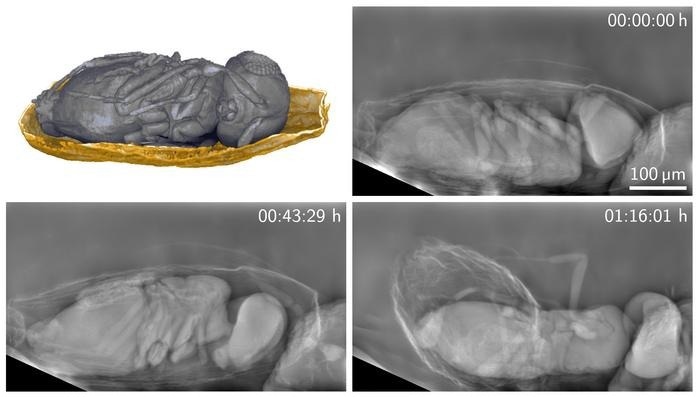Reviewed by Lily Ramsey, LLMDec 8 2023
Researchers have created an X-Ray imaging system that can capture intricate images of living creatures while using a far lower X-Ray dose than was previously achievable. Small organisms or other sensitive materials can now be investigated at high resolution for considerably longer periods of time, perhaps revealing new insights into a range of dynamic processes.
 A new X-Ray imaging technique can produce detailed images of living organisms with a much lower X-ray dose than previously possible. The researchers used the new technique to image tiny parasitoid wasps emerging from their host eggs for more than 30 minutes. Image Credit: Rebecca Spiecker, Karlsruhe Institute of Technology
A new X-Ray imaging technique can produce detailed images of living organisms with a much lower X-ray dose than previously possible. The researchers used the new technique to image tiny parasitoid wasps emerging from their host eggs for more than 30 minutes. Image Credit: Rebecca Spiecker, Karlsruhe Institute of Technology
The method is based on phase contrast imaging, which depends not only on X-Ray absorption in a material but also on X-Ray wave characteristics. It generates pictures from phase shifts caused by X-Rays passing through a specimen.
Previously, micrometer resolution X-Ray phase contrast imaging of living organisms was only possible for a few seconds up to minutes because severe radiation damage would occur. We reduced the necessary X-Ray dose by overcoming the current limitations of high-resolution imaging for dose-sensitive applications.
Rebecca Spiecker, PhD Student, Karlsruhe Institute of Technology
The researchers describe how they created a new X-ray imaging system that uses single-photon counting detectors and specialized, highly-efficient X-ray optics to increase the dose efficiency for full-field imaging at micrometer resolution in Optica, the journal for high-impact research published by Optica Publishing Group. For over half an hour, they watched as small parasitoid wasps emerged from their host eggs, showcasing the advantages of the novel approach.
Spiecker added, “We show that our method exhibits superior imaging performance compared to a conventional high-resolution detector. This could be useful, for example, for capturing details of the development and behavior of small model organisms, such as Xenopus frog embryos, over a longer time scale than is currently possible.”
Better Images with Less Radiation
Hidden structures and processes in living organisms can be revealed via X-ray imaging. However, it exposes organisms to toxic radiation at high levels, limiting the time that observations may be conducted before damage occurs.
This is exacerbated by the fact that the detection effectiveness of frequently used high-resolution detectors declines as resolution increases, requiring increasingly greater X-ray dosages to get a high-resolution image.
To address this issue, the researchers devised a phase contrast imaging method that immediately magnifies the X-ray image rather than transforming it to a visible light image and then magnifying it, as is the standard way. They could employ extremely efficient large-area detectors while preserving micrometer spatial resolution as a result.
The researchers employed a single-photon-counting imaging detector with a pixel size of 55 microns in the novel imaging system. A crystal optics device, a Bragg magnifier, is used to magnify the X-ray image behind the sample. To perform magnification, the latter comprises two flawless silicon crystals.
“To achieve the highest possible dose efficiency for full-field X-Ray imaging at micrometer resolution, we combine X-Ray phase contrast, a Bragg magnifier and a single-photon-counting detector, all optimized for an optimal X-Ray energy of 30 keV. The concept of Bragg magnifiers dates back to the late 1970s, and although their potential for increasing dose efficiency has been noted, it has not been explored until now,” Spiecker stated.
The researchers compared the performance of their novel system to a traditional high-resolution detector system using the same material, X-Ray fluence, and 30 keV X-Ray energy after demonstrating that it could achieve a dose efficiency of more than 90% while offering a resolution of up to 1.3 microns.
“At this energy, we showed that the detective quantum efficiency of our system exceeds the conventional system by over two orders of magnitude for the relevant high-resolution components of the image. At this energy, we showed that the detective quantum efficiency of our system exceeds the conventional system by over two orders of magnitude for the relevant high-resolution components of the image. This results in better images and allows a drastic reduction in the X-Ray dose in the sample,” Spiecker further added.
Imaging Tiny Insects
The technology was then utilized to conduct a preliminary behavioral study on living parasitoid wasps commonly used for biological pest management. Due to the little radiation exposure, scientists could get images of the small wasps within their host eggs for 30 minutes before the wasps emerged.
According to the researchers, the approach might also benefit biomedical applications such as delicate tomographic assessment of biopsy materials. On the other hand, using a Bragg magnifier necessitates a monochromatic, coherent, and collimated beam, which is accessible at X-ray synchrotron facilities.
They are also working to expand the system’s range of vision and boost its long-term mechanical stability for even longer measuring durations.
Journal Reference:
Spiecker, R, et. al. (2023) Dose-efficient in vivo X-ray phase contrast imaging at micrometer resolution by Bragg magnifiers. Optica. doi:10.1364/OPTICA.500978